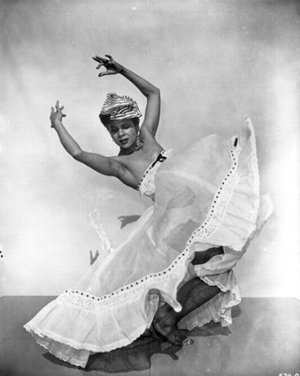Image may be NSFW.
Clik here to view. In a way to acknowledge the plethora of African Americans who have positively impacted and made invaluable contributions to the country, Southern Illinois University Edwardsville’s Black Heritage Committee chose to highlight several great Americans, including renowned dancer, choreographer, educator, anthropologist and social activist Katherine Dunham.
In a way to acknowledge the plethora of African Americans who have positively impacted and made invaluable contributions to the country, Southern Illinois University Edwardsville’s Black Heritage Committee chose to highlight several great Americans, including renowned dancer, choreographer, educator, anthropologist and social activist Katherine Dunham.
Dunham came to East St. Louis during the racial turmoil that gripped the nation in the 1960s, according to Dorian Brown, who received a master’s in history from SIUE in 1999. One of the most successful dancers in history, Dunham is credited to have ushered in the era of Black Concert dance during the 1940s.
“In 1964, she accepted an invitation from Southern Illinois University Carbondale (SIUC) to be an artist-in-residence, as well as oversee the choreography and staging for the opera Faust,” noted Brown, professor of history at St. Louis Community College and a PhD history candidate at Saint Louis University. “Later, Dunham was invited to help with the development of a dance and cultural arts program at the Alton campus. From there, she set her sights on East St. Louis as the target for a cultural educational initiative intended to improve the lives of the African American community.”
“By the time of Dunham’s arrival, East St. Louis was sharing the fate of other cities suffering from the nation’s urban crisis,” Brown continued. “It was plagued by deindustrialization, unemployment, poverty, white flight and crime. It was a shadow of the ‘All-American’ city status it had earned a decade earlier.”
SIU President Delyte Morris believed that the primary function of education was meeting the needs of its students and sought programs to improve the lives of the people in the region, according to Brown’s research. The University established a satellite campus in East St. Louis. Dunham’s celebrity, connections and collaboration were critical to the endeavor.
In 1967, the collaboration of Dunham and SIU resulted in the creation of the Experiment in Higher Education (EHE) and its cultural counterpart, the Performing Arts Training Center (PATC).
From its inception, the EHE was concerned with the educational and cultural development of its target population, which touted one of the first African centered college curriculum in the country, according to Eugene B. Redmond, PhD, SIUE emeritus professor of English.
“The PATC was a reflection of Dunham’s love of dance, experiences of growing up black in America, her training in anthropology, and her travels throughout the African diaspora,” Brown referenced. “The Dunham Technique was created as a form of protest to the racist ideologies and oppression of African culture in the U.S.”
The EHE and its auxiliary programs, including PATC, closed Nov. 6, 1978. However, several years later, some of Dunham’s protégés were instrumental in establishing the SIUE East St. Louis Center for the Performing Arts.
“Dunham’s protégés still continue the work she began, both locally and abroad,” said Brown.
SIUE concludes its Black Heritage Month on Thursday, Feb. 28 with Interim Assistant Provost Jessica Harris, PhD, as the keynote speaker and featured student performances.
Photo: Renowned dancer, choreographer, educator, anthropologist and social activist Katherine Dunham.
Image may be NSFW.Clik here to view.

